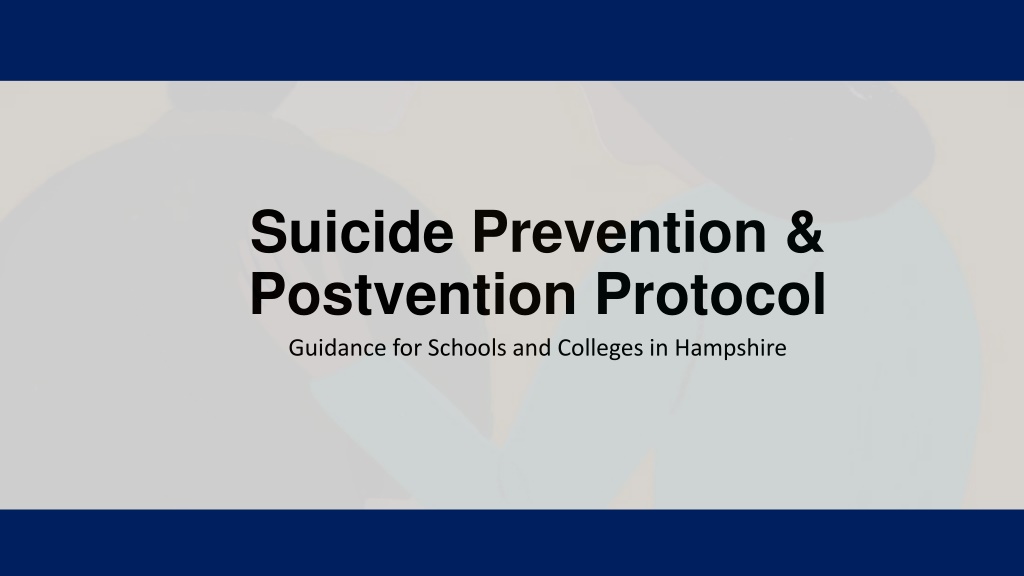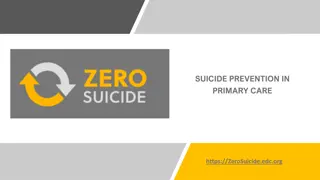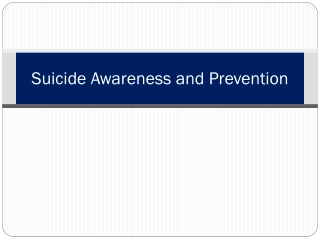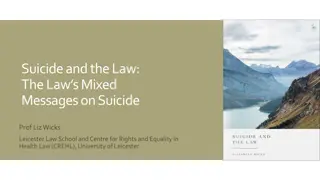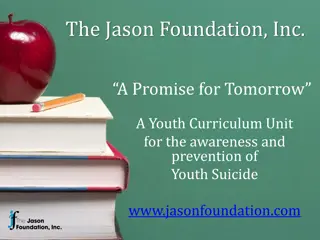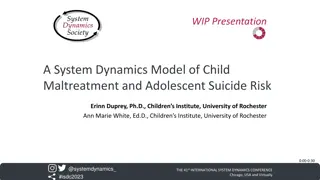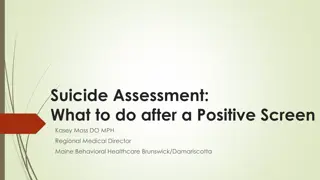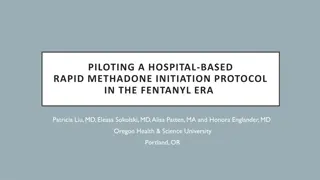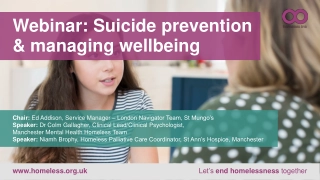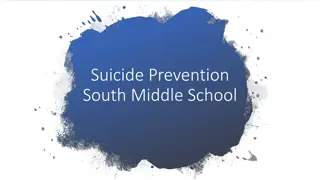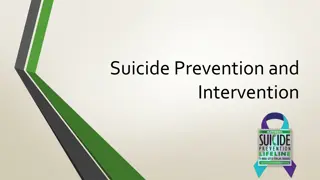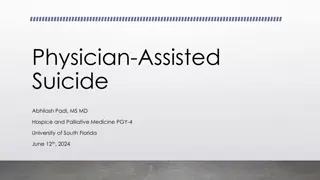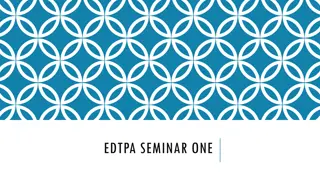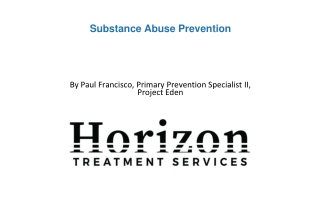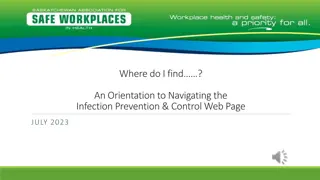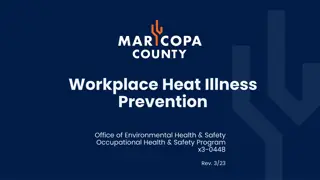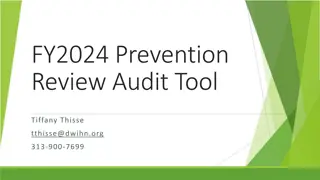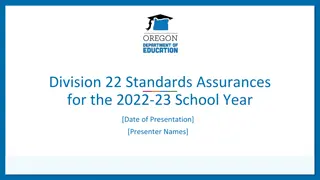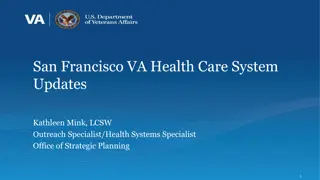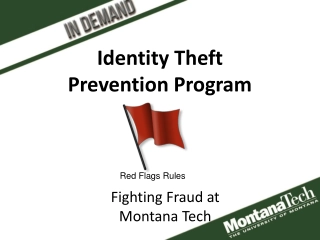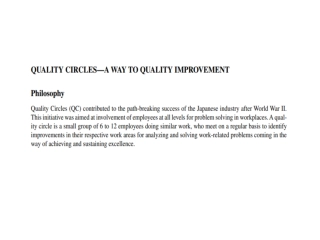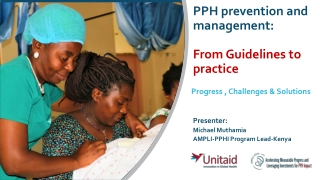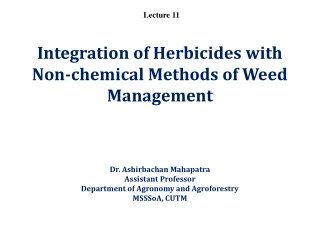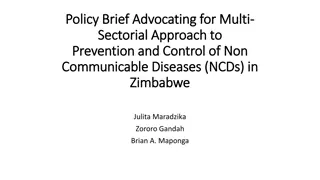Suicide Prevention & Postvention Protocol
This protocol provides practical advice and support for schools and colleges in Hampshire to navigate the aftermath of a suspected suicide among students or staff members. It includes guidance on interventions, critical incident response, and resources to support the bereaved. Key stages of the postvention protocol are outlined to help settings effectively address such situations.
Download Presentation
Please find below an Image/Link to download the presentation.
The content on the website is provided AS IS for your information and personal use only. It may not be sold, licensed, or shared on other websites without obtaining consent from the author. Download presentation by click this link. If you encounter any issues during the download, it is possible that the publisher has removed the file from their server.
Presentation Transcript
Suicide Prevention & Postvention Protocol Guidance for Schools and Colleges in Hampshire
Purpose of this support pack When someone dies by suspected suicide it can come as a sudden shock and sadness for those who knew them. It can be hard to navigate what steps your setting should be taking and what support is available for students, staff and the wider community. This document presents practical advice and support that schools and colleges should consider after a student or staff member has died by suspected suicide. It is intended for use by schools (primary through to secondary) and colleges in Hampshire. Settings may also find some of the guidance useful when a student is returning to your setting following a suicide attempt, or when a parent/guardian of a student has died by suspected suicide. 2
Useful Documents This document is intended to be read in conjunction with the following documents: Education Setting Suicide Prevention and Postvention Policy Template HIEP Critical Incident Packs (accessed via Educational Psychology team) HIPS Self-Harm and Suicidal Behaviour Pathway Samaritans Step by Step Resources 3
Glossary Term Definition A postvention is the name given to interventions conducted after a suspected suicide, largely taking the form of support for the bereaved (family, friends, professionals and peers). Postvention A death by suicide is confirmed at inquest. Before inquest, the death may be referred to as a suspected suicide. In the first instance, you may feel it is most appropriate to refer to the suspected suicide as a sudden death when communicating with students and parents. Any act of self-poisoning or self-injury carried out by an individual irrespective of motivation. This commonly involves self-poisoning with medication or self-injury by cutting. Suspected Suicide Self-Harm A critical incident is any incident which increases the risk of further self-harm/suicide attempts within your setting. This can include suspected suicide death of a student, suspected suicide death of a staff member, suicide attempt or serious self-harm incident of a student or staff member, suspected suicide death of a parent or sibling. Critical Incident Suicide Contagion Suicide contagion is the process where one person s suicide influences another person to engage in suicide acts. Contagion may be particularly likely to occur in circumstance here the second person is already contemplating a suicide act or is particularly vulnerable or impressionable. Often, those bereaved by suicide are family members and friends of a loved one who died by suicide. However, anyone in the wider community (including teachers, peers, and other parents/guardians) are also classified as bereaved by suicide and may require support. JAR stands for Joint Agency Response. The JAR process is triggered by child death review partners (e.g., health, safeguarding, and police colleagues) within the first 24hrs after a child dies (regardless of circumstances). Your setting is likely to be asked to participate in the JAR process when a student dies by suspected suicide. Bereaved by Suicide JAR 4
Postvention Protocol Stages The postvention response can be broken down into 7 key stages which follow in chronological order. This document will provide you with advice and guidance to support you through each of these stages. Stage 1: Develop, review and implement a whole settings approach to suicide prevention and postvention within your school or college. If not already in place, move onto stage 2. 1 2 Stage 2: Actions to take should you receive notification of a suspected suicide. Stage 3 (within 1 day): Convene a postvention response team; contact supporting organisations; participate in the joint agency response (JAR). 3 Stage 4: Timely contact with the family of the deceased; communicate with students and staff; provide bereavement and mental health support. 4 5 Stage 5: Identify vulnerable students/staff; monitor and provide support. Stage 6 (Week 2 onwards): Continue to support vulnerable students and staff; follow guidance on memorials, funerals; consider bereavement support and communications around key dates (e.g. inquest/anniversaries) and 6 Stage 7 (Within 6 months): Review and evaluate postvention response; provide feedback to HCC regarding lessons learned. 7 *Once complete, return to stage embedding your learning into your suicide prevention & postvention policy. 1 5
1 2 3 POSTVENTION RESPONSE OVERVIEW FLOWCHART 4 5 6 7 6
Contents Part I provides a high level overview of processes taken following a suspected suicide and Part II provides detailed guidance on implementing a response. Part III provides information about training and resources and also support to help with the preparation, planning and prevention process. Support for students and staff Communicating with students and staff PART I: EXEC SUMMARY OF PROCESSES Identifying and Supporting Vulnerable Children and Young People Know the warning signs and how to support Key Contact Information Stages Flowcharts/Checklists Notification of Suspected Suicide Convening a Postvention Response Team Postvention Response From Week 2 Onwards Supporting the JAR Process Check-In: The First Week in Review Week 2 Onwards Guidance on memorials and funerals PART II: DETAILED RESPONSE GUIDANCE Reviewing Evaluating & Learning from the Response Background: Why does Postvention matter? Check-In: Week 2- 6 Months in Review Check-In: Long-Term Suicide Prevention in Review Notification of Suspected Suicide: Roles & Responsibilities Summary Checklist PART III: PREPARATION, PLANNING & PREVENTION Training for Staff Resources for promoting positive mental health and resilience within your setting Signposting to Mental Health Support Services Suicide Prevention & Postvention Policy Guide Convening a Postvention Response Team: Detailed Roles and Responsibilities of the postvention response team Timely Communication with Family of the Deceased 7
PART I: Executive Summary of Processes Pages 8-13 provide a high level overview of the steps your organisation should take after a suspected suicide. 8 This section includes: Process maps for each stage of the process & key contact information for wraparound support offer
Key Contacts (1 of 2) 1 4 2 3 7 5 6 There are a number of organisations and services available to support your setting through all stages of your postvention response. Organisation Description of Support Contact Details Supporting senior leadership at the school. Please contact your HIAS Safeguarding Lead and the relevant County Education Manager for your setting Hampshire Inclusion and Advisory Service (HIAS) Educational Psychologists provide support and guidance to schools and colleges in response to a suspected suicide death of a student or staff member. Support is offered to any setting, regardless of whether you have an existing service level agreement with them or not. HIEP have also created two critical incident packs that provide guidance and signposting for settings. Following a suspected suicide death, as soon as possible, an educational psychologist will be in touch with the Headteacher/other senior leader. If you need to get in touch directly: West Dr Anna Nolan, 01962 876239 North Dan Taylor, 01252 814835 East Rachel Ingram, 01252 814729 South and Isle of Wight Dr Rebecca Murphy, 02392 441496 Hampshire and Isle of Wight Educational Psychology If service level agreement in place, HIEP can also support on organisational, policy and curriculum development, training and staff supervision. Following a suspected suicide or death of a young person: All young people that need to be referred via SPA to be referred in usual way. In-School support alongside other agencies. Meet with leadership team and identify any risky young people affected by the suicide and support referral into appropriate services. To be involved in one off group-work offer to the school alongside others (e.g., Amparo) Support staff/professionals with gaps in knowledge self-harm/ACEs etc. Young people who are of concern and open to CAMHS will be followed up by the local team. Requests to CAMHS for Postvention Support should be made to; North Hampshire: HantsCAMHSSPA@spft.nhs.uk South East Hampshire: HantsCAMHSSPA@spft.nhs.uk West Hampshire: HantsCAMHSSPA@spft.nhs.uk Hampshire CAMHS And also copied to Hampshire Safeguarding: Spnt.hantssafeguardingcamhs@nhs.net All emails should be titled: URGENT POSTVENTION SUPPORT FOR SCHOOLS Hampshire (Including SHIP) Amparo Anyone affected by a suspected suicide death Covers both children and adults-irrespective of their relationship to the person who has died or when the suspected suicide occurred Can support your setting with communicating with the family of the deceased as well as students and staff Referral Process: Complete referral form online https://amparo.org.uk/(consent required) The referral team will allocate a Suicide Liaison Worker who will begin to attempt contact within 24 hours Amparo offers to contact the Beneficiary within 7 days and complete a support plan and begin to signpost to relevant agencies. The SLW may contact the Coroner s Officer for more information or to pass over any information Amparo Bereavement Support Service Hampshire Public Health can provide support and guidance around communications, signposting to resources and advice on creating a whole settings approach to suicide prevention and postvention policy publichealthhampshire@hants.gov.uk Hampshire Public Health Team 9
Key Contacts (2 of 2) 1 4 2 3 7 5 6 Organisation Description of Support Contact Details Provides practical support to help settings prepare for and recover from a suspected or attempted suicide. They are happy to provide advice, guidance and support to any school, college, university or youth setting. stepbystep@samaritans.org 0808 168 2528 Leaving a message or an email would start the process. Samaritans Steps by Step Samaritans DEAL Resource also provides guidance on teaching emotional awareness within a school setting. DEAL: Developing Emotional Awareness and Listening Resource Provides bespoke guidance to a setting. They can support staff in managing conversations with young people and the wider community. Alex Hills, regional Papyrus Lead: Alex.Hills@papyrus-uk.org Lisa Roxby, national lead lisa.roxby@papyrus-uk.org Papyrus Key role in identifying vulnerable children and supporting staff to identify vulnerable children. The school nursing ChatHealth service is also a free resource available to families and young people who may be struggling with their mental health Hampshire Healthy Families Website School Nursing Support for Those Bereaved by Suicide SimonSays Most suitable for: Suspected suicide death of sibling/parent of student attending your setting Children and young people up to the age of 18 who have lost a significant person Please complete the referral form accessed here: simon-says-3rd-party-referral- 2021.pdf (simonsays.org.uk) and send the completed form to the email address below 023 8064 7550 info@simonsays.org.uk Simons Says Bereavement support charity for grieving children and families. They provide a wide range of support offers, online resources and publications designed to help guide . Please email or contact the team; they will talk with you to help identify what support a family needs Email: ask@winstonswish.org Free and confidential helpline: 08088 020 021 Winston s Wish Most suitable for: Suspected suicide death of sibling/parent of student attending your setting Children and young people up to the age of 25 after the death of someone significant in their lives. A national charity dedicated to supporting adults who have been bereaved by suicide. Winchester SOBS meets virtually on the 3rdWednesday of every month. Winchester Group Survivors of Bereavement by Suicide (uksobs.org) Telephone: 07763 644 310 Email: winchester@uksobs.org Winchester Survivors of Bereavement by Suicide Support Group (SOBS) 10
Flowchart: Notification of a Suspected Suicide 1 4 2 3 7 5 6 There are a number of ways that you may be notified about a suspected suicide or serious suicide attempt in your community. If you are alerted to a serious incident, it s important that you establish the facts as soon as possible so an appropriate course of action can be taken. How were you notified? Next Steps Student or staff member suspected suicide death: Convene a postvention/crisis response team (see guidance page 18) Joint Agency Response (JAR) Representative: You may be notified by a representative from the JAR process, often a health or police representative or via HIAS. Please notify the relevant county education manager so that they are aware that the story is circulating. If a suspected suicide death is confirmed through official channels, you will be notified via JAR or a school improvement manager. Parent/Sibling/Previous staff member suspected suicide death: No postvention response group needed; consult with HIAS if the impact of the death is significant and you feel a comprehensive postvention response is appropriate. Ensure affected student(s) and staff are offered suitable bereavement and/or mental health support (see page 9 & 10). School Community/Social Media: A report of a suspected suicide death or attempt could come from many different sources, particularly if the suspected suicide was of a parent or sibling of a student. It is important that this information is verified as soon as possible to prevent the spread of misinformation. Serious suicide attempt or self-harm incident: Unless a potential suicide cluster* has been identified, no crisis response team needed Ensure effective partnership working to support return to school after a serious incident, whereby the young person is at the centre of decision making Liaise with CAMHS locality lead regarding safety plan Hampshire County Council: You may be notified of the death of a sibling/parent or staff member by a school improvement manager from Hampshire County Council or through the JAR. *Special Consideration, Suicide Cluster:A suicide cluster describes a situation in which more suicides than expected occur in terms of time, place or both. It is difficult to precisely define but it usually includes 3 or more deaths; however, 2 suicides occurring in a specific community or setting (for example a school) in a short time period should also be taken very seriously in terms of possible links and impacts (even if the deaths are apparently unconnected), particularly in the case of young people. Self-harm and suicide attempts clusters can also occur. 11
Flowchart: Initial Postvention Response 1 4 2 3 7 5 6 The process map below provides a high level overview of the roles and responsibilities of your setting in the first three days after you have been notified of a suspected suicide death. Further guidance about roles and responsibilities can be found on page 19 . Remember, there are lots of agencies available to help support this team with the implementation of your response, these are outlined on page 9 & 10. Identify need for administrator to maintain accurate records of all actions taken and decisions made. Start: See notification of suspected suicide process map From 24hrs of notification: Participate in JAR Process [student death & attend other external meetings as required. Make executive decisions with response team, around additional support. Within week 1: Complete child death reporting form [student only] Identify need for postvention team chair Work with Amparo bereavement support service to engage with the family of deceased once police permission is given. Agree what information can be shared with peers, staff and the wider community. Amparo contact details are on page 9 Identify need for family liaison officer Day 1: Convene Postvention response team (see detailed roles and responsibilities guide page 19 ) : End: See Checklist Week 2 Onwards Liaise with HCC around communications and media enquiries. Use pre-agreed communication resources when speaking with students/staff/community. The comms toolkit is linked on page 3. Identify need for communications lead Day 1-3: Brief wider staff on suspected suicide death after family consent; offer bereavement support Contact/coordinate bereavement support services (with student care lead). Amparo contact details are on page 9 Identify need for care for staff lead Day 1-3: Brief students on suspected suicide; offer bereavement/mental health support Day 1-3: Provide HCC pre- prepared briefing for staff to use when speaking with students Identify need for care for student lead Contact/coordinate CAMHS support. Contact details are on page 9 12
Checklist: Postvention, Week 2 Onwards 1 4 2 3 7 5 6 Following your immediate response, it is important that students and staff continue to feel supported. It is likely that your school/college community will continue to need support long-term and in particular, around key dates (such as inquest) or anniversaries. Many of the organisations available to you in the postvention period, are also available to support longer term (see page 9 & 10 for contact information). Following a serious incident, it is also important to take the time to reflect on what has happened and the effectiveness of the postvention response. At this stage you may also wish to consider how your organisation could be better prepared for future suspected suicides, embedding any of the learning from your current response. Postvention Team Chair Care for Staff Lead Week 2 onwards: Communicate with CAMHS and Hampshire Inclusion and Advisory Service (HIAS) and relevant community sector organisations about any ongoing need for support. Week 2 onwards: Consider coordinating training around managing conversations about suicide and self-harm. See page 3 for a list of available training. Within 6 months: Lead reflection and evaluation of the postvention response. Provide feedback to Hampshire Public Health to improve future postvention responses. See page 27 Week 2 onwards: Provide enhanced wellbeing support for staff involved in JAR process. See page 35 From 6 months onwards: Consider enhanced support needed around anniversaries or other key dates. See page 29 for further guidance. Care for Students Lead Week 2 onwards: Ensure staff continue to be alert to the signs that someone may be having suicidal thoughts See page 22 From 6 months onwards: Consider service level agreement with Educational Psychology Service, depending on capacity and where appropriate. See page 9 Ongoing: Ensure students are aware of the different types of support available to them, including continued access to Amparo bereavement support service. See pages 9 & 10, 34 Communications Lead Week 2 onwards: Continue to share any concerns around ongoing media with HCC Public Health. See page 9 Ongoing: Promote mental and emotional resilience by promoting a whole school approach to mental wellbeing. See page 31 From 6 months onwards: Use pre-prepared HCC communications around anniversaries or key dates Refer to the communications toolkit on page 3 and detailed guidance on communication on page 21 Within 6 months: Review, update or develop your settings suicide prevention and postvention policy in line with reflection and learning from this postvention response. See page 29 Week 2 onwards: Continue to ensure appropriate language is used by staff. See language guide. Family Liaison Lead Week 2: Work with Amparo to understand the family s views on school attendance at funerals and any memorials See page 20 Week 2 onwards: Continue to act as school/family liaison link (potentially through to inquest) See page 20 One year post incident: Consider sending a card of condolences to the family of the deceased on anniversary of the death. See page 26. 13
PART II: Detailed Response Guidance Pages 15-29 provide detailed guidance and advice regarding the actions your setting should take following a serious incident. This section includes: Detailed guidance on actions taken & checklists of action for each stage of the postvention process14
Background: Why is a Postvention Response Needed? When someone dies by suspected suicide there is an immediate and often devastating effect on the people around them. Suicide has a ripple effect on the community and one report indicates that people bereaved by the sudden death of a friend or family member are 65% more likely to attempt suicide if the deceased died by suicide than if they died by natural causes. When a death by suspected suicide affects young people (<25 yrs.) this ripple effect is even more likely to occur. Although rare, this can result in a suicide cluster: whereby multiple young people take their lives following a suicide loss. https://www.ucl.ac.uk/news/2016/jan/1-10-suicide-attempt-risk-among-friends-and-relatives-people-who-die-suicide 15
Notification of a Suspected Suicide 1 4 2 3 7 5 6 There are a number of ways that you may be notified about a suspected suicide or serious suicide attempt in your community. If you are alerted to a suspected suicide or serious suicide attempt, it s important that you establish the facts as soon as possible so an appropriate course of action can be taken. You can help your setting be prepared before a suspected suicide or suicide attempt occurs by having a suicide prevention and postvention policy in place (see page 36). 16 .
Check-In: Notification of a Suspected Suicide Summary of Responsibilities 1 4 2 3 7 5 6 The table below provides a high level summary of your role as an education setting if you are notified of a suspected suicide. It also highlights the role of the Hampshire County Council and other agencies in supporting you through this process. The guiding principles on the right hand side should be kept in mind whilst handling the notification of a suspected suicide. Summary of Actions to Take Following a Notification Guiding Principles Responsibility of the Setting Establish the facts; contact the relevant county education manager if you are notified of a suspected suicide via informal communication pathways (e.g., word of mouth/social media) Try to stay calm, do not use language which goes beyond what has been confirmed Ensure staff understand the need for confidentiality; helping to manage any potential contagion* Act in accordance with data protection and information sharing protocols, protect the privacy and dignity to those affected Never reference the method of suspected suicide in conversation; following appropriate language guide Review your suicide and self-harm prevention and postvention policy and prepare to convene a postvention/postvention response group as necessary. If no policy or plan in place, use the roles & responsibilities guide on page 19 in this document to support. Responsibility of Supporting Agencies Once notified of a suspected suicide, contact the affected settings as soon as possible, including at evening and weekends If contacted by the setting, verify that a suspected suicide has occurred; share appropriate information and consider out-of-hours response Where appropriate, notify agencies available to support the education setting that a suspected suicide has occurred (e.g., educational psychology/ CAMHS) 17
Convening the Postvention Response Team 1 4 2 3 7 5 6 Once you have been notified that a suspected suicide has occurred, you should convene a postvention response team. The purpose of the postvention/crisis response team for your setting is to ensure action is coordinated in a systematic and timely manner. There are four main aims of this group: Coordinated and appropriate communications response Timely communication with family of the deceased Support for students and staff Maintain accurate records and support the joint agency review (JAR) and/or other safeguarding procedures. Further details on the specific roles and responsibilities of this group can be found on page 19. The JAR process will be happening alongside your postvention response. It is important that you maintain communication with this group so that responses align. Supporting organisations may advise and support the standing down of this group when appropriate. 18
Convening the Postvention Response Team 1 4 2 3 7 5 6 Your postvention response team should include the following roles & responsibilities. External organisations outlined on page 9 & 10 are available to provide guidance and support to your postvention group. Role Responsibilities Promptly convenes the postvention team/crisis response team meetings as necessary Chairs meetings Engages key people following a suspected suicide Represents the educational establishment at other meetings as appropriate. Financial budget planning, consider costs of covering staff absence Postvention Team Chair This may be The Headteacher/Designated Senior Leader Engages with the family following a suspected (with support from Amparo) Identify any requests they may have in respect of the educational setting Provides a single consistent point of contact for the family through entire JAR process Signposts to further support where appropriate The family may have a FLO from the police so will need to join up with them as well Family Liaison Officer This may be The Pastoral Lead(s). A sensitive and compassionate manner is crucial Keeps a detailed written record of all actions taken and decisions made. Maintains up to date contact numbers of key parents, emergency support services and other external contacts Close down deceased young person s files at an agreed time with senior leadership Sends out letters and emails where required Contacts organisations available to support as required Administrator This may be the administration lead Act as a single source of truth for parents and the wider community. Works closely with the local authority to communicate prepared statements to media, parents and the wider community Notify local authority staff of any media enquiries Communications Lead A member of the senior leadership team Engages with students and facilitates academic and pastoral support and guidance Identifies any students who may need additional support; make referrals/notify services as appropriate Closely monitor students missing lessons or that have unauthorised absences. Follow standard safeguarding procedures if you have concerns about a student and speak with your appointed CAMHS early help team member for further clarification Care for students lead This may be the designated safeguarding lead; head of year etc. Provide regular briefings to staff, governors and extended services; ensure staff have been briefed on what to share with students Identify any staff who may need additional support and make referrals to support services Be mindful of the impact that supporting an inquest/child death review can have on staff and their wellbeing. Be prepared to signpost to appropriate support in the long term. Coordinate any training for managing suicidal conversations with students Care for staff lead This may be the wellbeing/mental health lead, safeguarding lead or other member of the senior leadership team 19
Timely Communication with Family 1 4 2 3 7 5 6 There are a number of ways that you may be notified about a suspected suicide or serious suicide attempt in your community and it s important that you establish the facts as soon as possible. You should liaise with your JAR point of contact before reaching out to the family to get police permission. In addition, before communicating with the family, you may wish to contact Amparo Bereavement Support Service (contact details provided on page 9). They may already be supporting the family and can help to facilitate conversations between the student s family and your settings appointed family liaison lead. Families need consistency and the appointed family liaison lead must be prepared to be their primary contact for as long as they need it. If the parents are separated, ensure both are kept informed in the same way and each have the opportunity to express their views and wishes. Any communication with students and staff should be guided by the wishes of the family of the person who has died. No information about the death should be shared with students and the wider community until the family has been consulted. If the family has been notified that the death is a suspected suicide, they may not wish for this to be disclosed. You may wish to explain that students may already talking about the death amongst themselves and having adults in the school who are able to talk to students about suicide and sudden death can help to keep people safe. If the family refuses to permit disclosure, you must respect this. Stop all general administrative communication (e.g., letters/texts/emails about school trips or parent consultation events) to the family as soon as possible. 20
Support for Students and Staff 1 4 2 3 7 5 6 Timely communication with students and staff is an important part of helping to stabilise the situation, preventing rumours from circulating and ensuring access to bereavement support is available as soon as possible. Once the facts of the incident have been established, a briefing for all staff should be given. It is important to recognise that staff who knew the student most closely, are likely to be grieving themselves and should not be asked to lead on notifying others. Give due regard for the needs of students who were close to the deceased and consider notifying them separately. 2. Bereavement Support People affected by suicide will need various types of levels of support. The breadth of available support is outlined on the next page. 1. Communicate with Students and Staff Guidance and example communications can be found here. Wherever possible, briefings and conversations with both staff and students should happen face-to-face, with arrangements for immediate counselling and/or emotional support available. There are some general guidelines that are important for staff to keep in mind when having conversations. These are designed to reduce the likelihood of multiple suicides: 3. Signposting to Mental Health Resources In addition to bereavement support, both students and staff should be signposted to mental health and wellbeing services. A list of these can be found on page 32 of this document. Avoid sensationalising or normalising suicide Remain sensitive and factual in all conversations Never reference the method of suicide in any conversations Do not be afraid to use the term suspected suicide and avoid euphemisms Discourage students from posting about what has happened on social media, highlighting the potential impact on loved ones. 4. Identify Vulnerable Young People In addition to bereavement support, ensure staff are aware of the policies and procedures around identifying vulnerable young people. Consider providing training for staff in managing suicidal conversations and special care should be given to monitoring unauthorised absences or missed lessons. Further information can be found here. CAMHs can support discussions in relation to children and young people identified as at risk. Further information can be found on slide 22. You may find it appropriate to follow-up these conversations with letters to parents which detail the types of support available to students as well. People process information and grieve in different ways. Therefore, conversations with students and staff should be ongoing. The right time to access support is different for everyone. 21
Identifying and supporting children and young people with a risk of harm (1 of 2) 1 4 2 3 7 5 6 A suspected suicide can throw up all kinds of feelings and each person will react in their own way. There is some evidence to suggest that people who have previously experienced bereavement by suicide, irrespective of how much time has passed since the suspected suicide, may be more vulnerable. Therefore, it s important that staff, parents, and carers are aware of the warning signs following a suspected suicide in the community. Your setting should work with an Early Help and/or a clinician from CAMHS to identify and support other vulnerable young people. The below guide is intended to act as a high level summary of how you can identify vulnerable children and young people, however, we recommend that staff complete suicide awareness training (outlined on pg. 30) to increase confidence and capability. Step 1: Know the warning signs. Some warning signs include: No sense of purpose in life-talks about how much life sucks Appearing tired and distant Withdrawal from friends and family Rage, anger, irritability Recklessness Dramatic mood changes Increased substance use Statements that indicate hopelessness or being a burden A change in routine: sleeping or eating more/less than usual Other situational risk factors such as relationship breakdown, household dysfunction, and bullying. Threatening suicide or talking about wanting to die* Looking for ways to die* *These warning signs indicate immediate suicide risk. Stay with the person who is exhibiting these signs and connect them to help. Step 3: Use Samaritans SHUSH Listening Tips The below tips to help you manage the conversation Step 2: Talk to the child/young person Papyrus have a helpful conversation starters guide to help you initiate the conversation with a child/young person found here. There are also organisations available to support these conversations following a suspected suicide. These are listed on page 14. 22
Identifying and supporting children and young people with a risk of harm (1 of 2) 1 1 4 4 2 2 3 3 7 7 5 5 6 6 Step 4: Inform the designated safeguarding lead & notify parents/carers. Follow your setting s safeguarding policy if you have concerns that a child or young person is experiencing suicidal thoughts. Parents/guardian consent is required to discuss the child with multi-agency partners (e.g., CAMHS) Step 5: Seek advice or referral to CAMHS and raise safeguarding concerns as appropriate One clinician from Early Help and one clinician from Locality CAMHS is available to support students following a suspected suicide. See page 9 for contact details and further information. Out of hour crisis support is available from the NHS 111 Mental Health Triage Team. Step 6: Log Incident and agree next steps Log incident and steps taken Continue talking to child/young person; it may be useful to share resources for additional support and information with them, such as the Stay Alive App which has a customisable wellbeing plan tool that the child/young person can develop with their parent/guardian. If you are worried that the child/young person is in danger, call 111 (24 hours a day, 7 days a week) and ask to speak to the Mental Health Triage Team. Where a child s safety is at immediate risk, contact the police by dialling 999. Information Sharing and Data Processing; There is a clear expectation is that all professionals will discuss their concerns openly and honestly with the child, where appropriate, and their parents or carers/ those with parental responsibility. The only exception to this is where to do so might place the child or another person at likelihood/ immediate risk of harm. Further guidance and support on identifying and supporting vulnerable students can be found in the Samaritans Step by Step resources Identifying & supporting vulnerable students | Mental health in schools | Samaritans 23
Support the JAR Process From 24 hours onwards 1 4 2 3 7 5 6 Your setting is likely to be asked to participate in the Joint Agency Response (JAR). The JAR is part of the Child Death Review process. More information about this process can be found here. If the JAR process is triggered, a JAR Phase 1 meeting will be called and consideration will be given throughout as to the necessity for continuing to a JAR Phase 2 meeting and a final JAR Phase 3 meeting (Child Death Review Meeting). If at any time information becomes available that suggests the death was expected, then there is no requirement to continue the full JAR process. In the case of an unexpected death, the Child Death Review Meeting will form part of the final case discussion in the JAR 3 final meeting. You will be asked by the CDOP Team to complete a statutory Child Death Reporting Form shortly after the death. This form is to be returned to the local CDOP Team so it can be shared with the National Child Mortality Database. This form may be available to you online but can also be downloaded here. JAR meetings can be very distressing for those attending. If you feel support is needed for staff attending, a list of support available can be found on page 35 24
Check-In: The First Week Summary of Responsibilities 1 4 2 3 7 5 6 The table below provides a high level summary of your role as an education setting in supporting the postvention response during the first week. It also highlights the role of the Hampshire County Council and other agencies in supporting you through this process. The guiding principles on the right hand side should be kept in mind whilst putting in place your postvention response. Summary of Immediate Actions to Take Responsibility of the Setting Guiding Principles Convene a postvention/crisis response team Respond with compassion and respect Be sensitive to the needs of others Ensure timely engagement with the family, staff and students Follow established language guidelines when talking about a suspected death by suicide found here Recognise that talking about suicide responsibly does not increase the likelihood of further suicidal behaviours Act in accordance with data protection and information sharing protocols, protect the privacy and dignity to those affected Ensure that peers and staff are supported and able to access services when suicide bereavement affects them. Make use of the wraparound support offered by other agencies; they can support the crisis response team & offer bereavement support for students and staff Liaise with family members of the deceased with the support of Amparo Provide briefings for staff and governors as needed Use the pre-agreed communications response tools prepared by Hampshire County Council Keep an accurate record of all actions taken and decisions made Advise staff on procedures for identification of other vulnerable young people Responsibility of Supporting Agencies Set up Joint Agency Review (JAR) response Establish single point of contact for the school through JAR response Ensure bereavement support services are offered to students and staff Provide pastoral support for staff involved in the postvention/crisis response team and JAR Notify any other settings attended by deceased's siblings/relatives (e.g., younger siblings school) through JAR Provide communication resources for the school 25 Handle media enquiries
Week 2 Onwards 1 4 2 3 7 5 6 Following your immediate response, it is important that students and staff continue to feel supported. People may also be looking for ways to come together to pay tribute and your setting can provide appropriate guidance and support for funerals, memorials and key dates. Continue to use the guidance provided on page 22 when identifying children and young people at risk of suicide and self-harm. You may also wish to consider suicide prevention training outlined on page 32 or explore opportunities to put in place a service level agreement with Hampshire and Isle of Wight Educational Psychology Service in the future. Irrespective of whether your setting has a mental health support team, your setting can also choose to attend a locality Mental Health Forum which is organised by Hampshire CAMHS. The Mental Health Forum offers a unique opportunity for education professionals to come together to collaboratively explore mental health best practice. Facilitated by CAMHS clinicians, the half-termly forums provide a safe space for confidential case discussions to be held within school settings. Guidance on Memorials and Funerals The guidance below is from the Samaritans Steps by Step Guide. Memorials Memorials should be handled with great care and sensitivity. It is important to acknowledge the desire for the memorial but also recognise the potential risk of glamorising and sensationalising a suspected suicide death. This can unintentionally increase the risk of others taking their own lives. Please ensure you set an appropriate time limit to the memorial (no more than two weeks) and strive to treat all deaths in the same way Funerals Depending on the wishes of the family, the education setting may wish to rend representative/s to attend the funeral service. Samaritans recommends the following: Parents or guardians accompany students who want to attend. Those who don t attend should have normal classes to go to. If appropriate, engage the faith leader prior to the funeral to suggest that In the longer term, memorials can be organised (tree/plant/plaque etc.) Sending a card to the parents/family one year after the incident can be a supportive gesture and one that may be appreciated. 26
Reviewing, evaluating & learning Within 6 months 1 4 2 3 7 5 6 Following a serious incident, it is important to take the time to reflect on what has happened and the effectiveness of the postvention response. There will be recommendations that come from the JAR, however, it is also useful for individual schools and colleges that have implemented a postvention response to reflect on what worked well and what could have been better. We have provided a few prompts for your postvention response team to consider. Please share feedback with Hampshire Public Health so that we can use this feedback to inform iterations of this document. Any recommendations should also be fed into your internal suicide prevention and postvention policy. Key Questions Ask whether the relevant policies and procedures were effective. Did staff use them? Were they fit for purpose? Was the support available for students and staff sufficient? What other support would you have liked from supporting agencies? After the immediate response, was support sufficient? Samaritans Step by Step can provide expert support to settings reviewing a response and developing/improving their postvention plan. Call 0808 168 2528. Recommendations: Share any feedback about the postvention process with Hampshire County Council Public Health so that it can be incorporated into future responses. You can get in touch with Public Health at publichealthhampshire@hants.gov.uk 27
Check-In: Week 2- 6 Months Summary of Responsibilities 1 4 2 3 7 5 6 The table below provides a high level summary of your role as an education setting in supporting the postvention response from week 2 onwards. It also highlights the role of the Hampshire County Council and other agencies in continuing to support your settings. The guiding principles on the right hand side should be kept in mind whilst progressing with your postvention response. Summary of Medium-Term Actions to Take Guiding Principles Responsibility of the Setting Continue to make use of the wraparound support offered by other agencies; they can continue to provide bereavement and mental health support for students and staff Recognise that everyone grieves differently and may need access to bereavement support or signposting to mental health services at different times Be sensitive to the needs of others Be mindful of the impact that support an inquest/child death review can have on staff and their wellbeing Follow established guidelines when talking about a suspected death by suicide Recognise that talking about suicide responsibly does not increase the likelihood of further suicidal behaviours Act in accordance with data protection and information sharing protocols, protect the privacy and dignity to those affected Participate in the JAR process as needed Liaise with family members around the funeral, memorial and other key dates where appropriate with the support of Amparo Use the pre-agreed communications response tools prepared by Hampshire County Council if there are any media queries around key dates. Contact appropriate organisations outlined on page 9 if enhanced support is needed Continue to support staff on procedures for identification of other vulnerable young people Review postvention policies and procedures and provide feedback to Hampshire Public Health to improve future postvention responses. Update internal policies and procedures accordingly Responsibility of Supporting Agencies Implement any recommendations from JAR and feedback received from the education setting Stay alert and aware to the increased risk of suicide and self-harm of students and staff affected by the suspected suicide death. Notify Hampshire Public Health if new information pertaining to suicide cluster emerges. Monitor social media and local media outlets for inappropriate reporting of the suspected suicide Continue to lead JAR process 28 Offer training opportunities to the setting where appropriate
Check-In: Long-Term Suicide Prevention Summary of Responsibilities 1 4 2 3 7 5 6 The table below provides a summary of your role as an education setting in supporting suicide prevention and postvention. It also highlights the role of the Hampshire County Council and other agencies in supporting you through this process. If you have questions or concerns about the responsibilities of supporting agencies. Please get in touch with Hampshire Public Health at publichealthhampshire@hants.gov.uk . Summary of Responsibilities Responsibility of the Setting Include self-harm and suicide prevention within your setting s safeguarding policy prior to a serious incident. Guiding Principles Have a postvention plan which assigns staff clear roles and responsibilities that have been agreed in advance. Take a whole setting approach to positive mental health and emotional wellbeing There is a shared understanding across your setting of what constitutes good mental health Support staff with their own mental health and wellbeing Senior leadership will continue to reinforce the message to all staff that we ALWAYS believe children and young people; raising awareness of suicide and self-harm risk factors. Know where and who to contact for support following a serious incident. Ensure staff are aware of their roles & responsibilities as outlined within this plan and that they are appropriately trained in suicide intervention and postvention. Responsibility of Supporting Agencies Provide practical resources that education settings can use when developing their self- harm and suicide prevention policies Provide a variety of workforce training opportunities for education staff so they can confidently manage conversations around suicidality and self-harm Support a whole settings approach to mental wellbeing 29
Preparation, Planning & Prevention Pages 31-36 provide detailed guidance and advice regarding the actions your setting should take to prepare and plan for a suicide- related incident and become suicide-safe. This section includes: Components of the Whole System Approach to Mental Health and Wellbeing, Staff Training and Resources available. 30
Preparation, Planning & Prevention Supporting your setting to become suicide safe. 1 4 2 3 7 5 6 Components of a Whole Setting Approach (WSA) to Mental Health and Wellbeing Effective suicide prevention is comprehensive: it requires a combination of efforts that work together to address different aspects of the problem. Your setting should consider the value in adopting a whole settings approach (WSA) to suicide prevention and postvention. This is the inclusion and prioritisation of health and wellbeing in all aspects of the setting, with the aim of building a culture and practices over time that promote good health. It involves everyone within the school. This section provides further information on where to start with a WSA to suicide prevention and postvention: Training for Staff Resources for promoting positive mental health and resilience within your setting Signposting to support when needed Suicide Prevention and Postvention Policy *Figure taken from The Children s Mental Health Coalition: Promoting Children and Young People s Mental Health and Wellbeing 31
Preparation, Planning & Prevention Training for Staff 1 4 2 3 7 5 6 The below information outlines the mental health and wellbeing training freely available to schools and colleges staff working in Hampshire. This training aims to reduce the stigma associated with talking about suicide and improve knowledge and understanding around children/young people emotional resilience and mental wellbeing. 3. Enhancing knowledge and skills 2. Developing knowledge and skills Suicide First Aid training aims to enhance skills in managing suicidal conversations and is available free of charge for frontline Hampshire staff. Hampshire Safeguarding Children s Partnership Suicide Awareness Training offers a wider variety of fully funded multi-agency events, including suicide awareness training. This webinar aims to increase awareness of the range of mental wellbeing and crisis intervention support available and to gain greater confidence in recognising when someone may be experiencing suicidality. 1. Awareness and understanding CARE (Coping and Resilience Education Skills) Workshop to help you understand young people s emotions and how to support them with emotional resilience and mental health. Hampshire CAMHS offer further e-learning to help your knowledge and understanding when supporting children/young people in distress. HIES Training Offers nine free e-learning modules on a range of health and wellbeing topics, including Emotional wellbeing and mental health and self- harm. Zero Suicide Alliance Awareness training which provides an understanding of the signs to look out for and skills required to approach someone who is struggling. Course length 10 to 20 minutes per module. 32
Preparation, Planning & Prevention Resources for promoting positive mental health and resilience within your setting 1 4 2 3 7 5 6 Resource/service Information Hampshire Health in Education is a public health programme for all early years and school settings in Hampshire. It aims to support you to take a whole setting approach to health and wellbeing supporting children, young people, and their families, including emotional wellbeing. Further resources can be found at the webpage below. https://www.hants.gov.uk/socialcareandhealth/publichealth/hampshirehealthineducation/keystages/secondary/emotionalwellbeing Hampshire Health in Education The Mental Health Forum offers a unique opportunity for education professionals to come together to collaboratively explore mental health best practice. Facilitated by CAMHS clinicians, the half-termly forums provide a safe space for confidential case discussions to be held within school settings. They are open to any school within Hampshire, irrespective of whether you have a Mental Health Support Team in place. https://hampshirecamhs.nhs.uk/issue/mental-health-support-teams/ Hampshire CAMHS Mental Health Forums Hampshire CAMHS provides guides, videos and podcasts on various mental disorder and emotional resilience topics designed to help you support children and young people or to use when teaching . Professionals CAMHS (hampshirecamhs.nhs.uk) Hampshire CAMHS Resources for Professionals A hub of resources for school and colleges to support education staff to adopt a whole school and college approach to mental health and wellbeing. They produce evidence-based training, resources and programmes, helping schools and colleges make the mental health of their pupils and staff a priority. https://www.annafreud.org/schools-and-colleges/ Anna Freud Centre Provides practical tips for teachers in the classroom through factsheets and film to support students emotional wellbeing at school. They also have tips for supporting the return to school for students https://nipinthebud.org/films-teachers-category/tips-for-teachers/ Nip in the Bud-Tips for Teachers Provides a wide range of information, resources and advice around supporting young people s mental and emotional health. You can view the extensive back catalogue of livestream events on various topics, including young people who self-harm. https://www.youthscape.co.uk/mentalhealthhub#browse-resources Youthscape Health Strong Resource Hub A collection of free lesson plans and videos across various mental health themes, approved by a clinical lead. Resource hub Now and Beyond Now and Beyond YoungMinds Mental Health Resources For Children and Young People | YoungMinds Lesson plans and guidance resource packs to teach about emotional wellbeing for different key stages. Search (pshe-association.org.uk) PSHE Mental Health and Emotional Wellbeing Lesson Plans Practical materials for primary and secondary schools to use to train staff about teaching mental wellbeing Teaching about mental wellbeing - GOV.UK (www.gov.uk) DfE Guidance for Teaching about mental wellbeing 33
Preparation, Planning & Prevention Signposting to mental health support when you need it [students] 1 4 2 3 7 5 6 Service Description of Support KOOTH Is a free, anonymous online counselling and emotional wellbeing support service for young people aged 11-25 years (up to 26th birthday) in Hampshire. It offers a safe way to access support for emotional health and wellbeing needs from a team of professional qualified counsellors. Counsellors are available 12noon - 10pm on weekdays and 6pm - 10 pm at weekends, every day of the year. No referral needed. Hampshire Children & Adolescent Mental Health services are made up of specialist teams offering assessment and treatment to children and young people up to age 17 who have moderate to sever mental health problems. Referrals can be made from GP, schools, school nurses and pastoral leads. Hampshire CAMHS ChatHealth A confidential text messaging service with a school nurse to support young people aged 11-19 in Hampshire on 07507 332160. Available Monday to Friday from 9am to 4.30pm (excluding bank holidays). The Little Blue Book of Sunshine The Little Blue Book of Sunshine is a mental health resource for children and young people in Hampshire. It aims to help by sharing tips on how to deal with problems such as anxiety, body image, relationships and anger. It includes information about national and local resources. The booklet is available on Apple Books and Google Play Books. Text 'HANTS' to 85258. (Free service) Open 24 hours a day, 7 days a week, every day of the year. Trained volunteers are there for you 24/7 to listen and support you to get to a calmer and safe place. Shout is a free, confidential, anonymous service for anyone in the UK. It won t appear on your phone bill SHOUT Childline can be contact by phone or through their website. It is open 24/7. ChildLine Call 111 or visit www.111.nhs.uk and ask to speak to the NHS Mental Health Triage Service. This service provides advice, support and guidance, 24/7. The Mental Health Triage Team is comprised of mental health nurses who can offer brief psychological support and make referrals into appropriate services. NHS 111 Mental Health Triage Service 34
Preparation, Planning & Prevention Signposting to support when you need it [staff] 1 4 2 3 7 5 6 Service Description of Support Health Assured Helpline/Employee Assistance Programme Access to the service will depend on whether your setting has purchased this service. Where your setting has purchased the service, it will be available to all staff, except agency/supply. There service is available 24/7 Education Support UK charity dedicated to supporting the mental health and wellbeing of teachers and education staff in schools and colleges. Mental Health and Wellbeing Guide for Managers This guide is for managers and provides an overview of the range of external health and wellbeing support available. Hampshire Isle of Wight Educational Psychology Team Educational Psychologists provide support to staff following any critical incident. If service level agreement in place, HIEP may also provide additional support/training for staff. Mental Wellbeing Hampshire Mental Wellbeing Hampshire provides further information on mental wellbeing and crisis care locally for adults and young people. NHS 111 Mental Health Triage Service Call 111 or visit www.111.nhs.uk and ask to speak to the NHS Mental Health Triage Service. This service provides advice, support and guidance, 24/7. The Mental Health Triage Team is comprised of mental health nurses who can offer brief psychological support and make referrals into appropriate services. 35
Preparation, Planning & Prevention Education Setting Suicide Prevention and Postvention Policy Guide 1 4 2 3 7 5 6 Both Samaritans and Papyrus recommend that schools and colleges develop a suicide safety policy which is known by the whole community and which is focused on suicide prevention. We have created a template here to help you develop your own suicide safety policy (to be included within Safeguarding policy). At a minimum, your policy should include the following elements: Ensure all staff are self-harm and suicide aware. Commitment to deliver lessons on mental ill health and provide clear pathway(s) for pupils to raise concerns to staff. Enhance physical safety of the environment, including the removal of potential ligature points, restricting access to places which facilitate jumping, and securing storing harmful substances. A named postvention response team who are familiar with the Hampshire Suicide Prevention & Postvention Protocol and have a clear understanding of their roles and responsibilities in the event of a suspected suicide or suicide attempt. Have a named staff member responsible for the design, implementation, and maintenance of this policy. An example policy from a school in Hampshire can be shared upon request to publichealthhampshire@hants.gov.uk Reducing the risk of suicide will also already well-supported by many policies your settings may have. These include the following: Child protection/safeguarding Anti-bullying Behaviour and Relationships Staff Training Staff/CYP Emotional Wellbeing Bereavement Policy 36
For comments/feedback or questions about this document, please get in touch with Hampshire Public Health, public.health@hants.gov.uk
